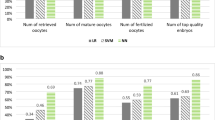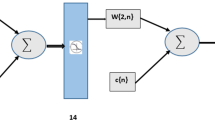Abstract
Purpose
To construct and validate an efficient artificial neural network (ANN) based on parameters with statistical correlation to live birth, to be used as a comprehensive tool for the prediction of the clinical outcome for patients undergoing ART.
Methods
Data from 257 infertile couples that underwent a total of 426 IVF/ICSI cycles from 2010 to 2017 was collected on an ensemble of 118 parameters for each cycle. Statistical correlation of the parameters with the outcome of live birth was performed, using either t test or χ2 test, and the parameters that demonstrated statistical significance were used to construct the ANN. Cross-validation was performed by random separation of data and repeating the training-testing procedure by 10 times.
Results
12 statistically significant parameters out of the initial ensemble were used for the ANN construction, which exhibited a cumulative sensitivity and specificity of 76.7% and 73.4%, respectively. During cross-validation, the system exhibited the following: sensitivity 69.2% ± 2.36%, specificity 69.19% ± 2.8% (OR 5.21 ± 1.27), PPV 36.96 ± 3.44, NPV 89.61 ± 1.09, and OA 69.19% ± 2.69%. A rather small standard deviation in the performance indices between the training and test sets throughout the validation process indicated a stable performance of the constructed ANN.
Conclusions
The constructed ANN is based on statistically significant variables with the outcome of live birth and represents a stable and efficient system with increased performance indices. Validation of the system allowed an insight of its clinical value as a supportive tool in medical decisions, and overall provides a reliable approach in the routine practice of IVF units in a user-friendly environment.


Similar content being viewed by others
References
Vander Borght M, Wyns C. Fertility and infertility: definition and epidemiology. Clin Biochem. 2018;62:2–10.
Mascarenhas MN, Flaxman SR, Boerma T, Vanderpoel S, Stevens GA. National, regional, and global trends in infertility prevalence since 1990: a systematic analysis of 277 health surveys. PLoS Med. 2012;9:e1001356.
Ombelet W, Cooke I, Dyer S, Serour G, Devroey P. Infertility and the provision of infertility medical services in developing countries. Hum Reprod Update. 2008;14:605–21.
Inhorn MC, Patrizio P. Infertility around the globe: new thinking on gender, reproductive technologies and global movements in the 21st century. Hum Reprod Update. 2015;21:411–26.
De Geyter C, Calhaz-Jorge C, Kupka MS, Wyns C, Mocanu E, Motrenko T, et al. The European IVF-monitoring Consortium (EIM) for the European Society of Human Reproduction and Embryology (ESHRE); ART in Europe, 2014: results generated from European registries by ESHRE: the European IVF-monitoring Consortium (EIM) for the European Society of Human Reproduction and Embryology (ESHRE). Hum Reprod. 2018;33:1586–601.
Baker VL, Luke B, Brown MB, Alvero R, Frattarelli JL, Usadi R, et al. Multivariate analysis of factors affecting probability of pregnancy and live birth with in vitro fertilization: an analysis of the Society for Assisted Reproductive Technology Clinic Outcomes Reporting System. Fertil Steril. 2010;94:1410–6.
Lieberman BA, Falconer D, Brison DR. Presentation of in-vitro fertilisation results. Lancet. 2001;357(357):397.
De Mouzon J, Goossens V, Bhattacharya S, Castilla JA, Ferraretti AP, Korsak V, et al. Assisted reproductive technology in Europe, 2006: results generated from European registers by ESHRE. Hum Reprod. 2010;25:1851–62.
Kovalevsky G, Patrizio P. High rates of embryo wastage with use of assisted reproductive technology: a look at the trends between 1995 and 2001 in the United States. Fertil Steril. 2005;84:325–30.
Somashekhar SP, Kumarc R, Rauthan A, Arun KR, Patil P, Ramya YE. Double blinded validation study to assess performance of IBM artificial intelligence platform, Watson for oncology in comparison with Manipal multidisciplinary tumour board – first study of 638 breast cancer cases. Cancer Res. 2017;77:S6–07.
Esteva A, Kuprel B, Novoa RA, Ko J, Swetter SM, Blau HM, et al. Dermatologist-level classification of skin cancer with deep neural networks. Nature. 2017;542:115–8.
Bouton CE, Shaikhouni A, Annetta NV, Bockbrader MA, Friedenberg DA, Nielson DM, et al. Restoring cortical control of functional movement in a human with quadriplegia. Nature. 2016;533:247–50.
Farina D, Vujaklija I, Sartori M, Kapelner T, Negro F, Jiang N, et al. Man/machine interface based on the discharge timings of spinal motor neurons after targeted muscle reinnervation. Nat Biomed Eng. 2017;1:0025.
Dilsizian SE, Siegel EL. Artificial intelligence in medicine and cardiac imaging: harnessing big data and advanced computing to provide personalized medical diagnosis and treatment. Curr Cardiol Rep. 2014;16:441.
Johnson KW, Torres Soto J, Glicksberg BS, Shameer K, Miotto R, Ali M, et al. Artificial intelligence in cardiology. J Am Coll Cardiol. 2018;71(23):2668–79.
Jing Y, Bian Y, Hu Z, Wang L, Xie X. Deep learning for drug design: an artificial intelligence paradigm for drug discovery in the big data era. AAPS J. 2018;20:58.
Sniecinski I, Seghatchian J. Artificial intelligence: a joint narrative on potential use in pediatric stem and immune cell therapies and regenerative medicine. Transfus Apher Sci. 2018;57:422–4.
Simopoulou M, Sfakianoudis K, Maziotis E, Antoniou N, Rapani A, Anifandis G, et al. Are computational applications the “crystal ball” in the IVF laboratory? The evolution from mathematics to artificial intelligence. J Assist Reprod Genet. 2018;35:1545–57. https://doi.org/10.1007/s10815-018-1266-6.
Basheer IA, Hajmeer M. Artificial neural networks: fundamentals, computing, design, and application. J Microbiol Methods. 2000;43:3–31.
Kaufmann SJ, Eastaugh JL, Snowden S, Smye SW, Sharma V. The application of neural networks in predicting the outcome of in-vitro fertilization. Hum Reprod. 1997;12:1454–7.
Wald M, Sparks A, Sandlow J, Van-Voorhis B, Syrop CH, Niederberger CS. Computational models for prediction of IVF/ICSI outcomes with surgically retrieved spermatozoa. Reprod BioMed Online. 2005;11:325–31.
Uyar A, Bener A, Ciray H, Bahceci M. A frequency based encoding technique for transformation of categorical variables in mixed IVF dataset. Conf Proc IEEE Eng Med Biol Soc. 2009;2009:6214–7.
Banerjee P, Choi B, Shahine LK, Jun SH, O’Leary K, Lathi RB, et al. Deep phenotyping to predict live birth outcomes in in vitro fertilization. Proc Natl Acad Sci U S A. 2010;107:13570–5.
Uyar A, Bener A, Nadir Ciray H, Bahceci M. Handling the imbalance problem of IVF implantation prediction. IAENG Int J Comput Sci. 2010;37:2.
Ballester M, Oppenheimer A, D’Argent EM, Touboul C, Antoine JM, Coutant C, et al. Nomogram to predict pregnancy rate after ICSI-IVF cycle in patients with endometriosis. Hum Reprod. 2012;27:451–6.
Choi B, Bosch E, Lannon BM, Leveille MC, Wong WH, Leader A, et al. Personalized prediction of first-cycle in vitro fertilization success. Fertil Steril. 2013;99:1905–11.
Durairaj M, Thamilselvan P. Applications of artificial neural network for IVF data analysis and prediction. JEC AS. 2013;2(9):11–5.
Manna C, Nanni L, Lumini A, Pappalardo S. Artificial intelligence techniques for embryo and oocyte classification. Reprod BioMed Online. 2013;26:42–9.
Milewski R, Milewska AJ, Więsak T, Morgan A. Comparison of artificial neural networks and logistic regression analysis in pregnancy prediction using the in vitro fertilization treatment. SLGR. 2013;35:39–48.
Durairaj M, Nandhakumar R. An integrated methodology of artificial neural network and rough set theory for analyzing IVF data. 2014 International Conference on Intelligent Computing Applications, Coimbatore, 2014, pp. 126–129
Uyar A, Bener A, Ciray HN. Predictive modeling of implantation outcome in an in vitro fertilization setting: an application of machine learning methods. Med Decis Mak. 2015;35:714–25.
Milewski R, Kuczyńska A, Stankiewicz B, Kuczyński W. How much information about embryo implantation potential is included in morphokinetic data? A prediction model based on artificial neural networks and principal component analysis. Adv Med Sci. 2017;62:202–6.
Siristatidis C, Pouliakis A, Chrelias C, Kassanos D. Artificial intelligence in IVF: a need. Syst Biol Reprod Med. 2011;57:179–85.
Siristatidis C, Vogiatzi P, Pouliakis A, Trivella M, Papantoniou N, Bettocchi S. Predicting IVF outcome: a proposed web-based system using artificial intelligence. In Vivo. 2016;30:507–12.
Ferraretti AP, La Marca A, Fauser BC, Tarlatzis B, Nargund G, Gianaroli L, et al. ESHRE consensus on the definition of ‘poor response’ to ovarian stimulation for in vitro fertilization: the Bologna criteria. Hum Reprod. 2011;26:1616–24.
Mascarenhas M, Balen AH. The high responder: a review of pathophysiology and outcomes during IVF treatment. Hum Fertil (Camb). 2017;20:155–67.
Zegers-Hochschild F, Adamson GD, Dyer S, Racowsky C, de Mouzon J, Sokol R, et al. The international glossary on infertility and fertility care, 2017. Fertil Steril. 2017;108:393–406.
DiMaggio C. SAS for epidemiologists: applications and methods. New York: Springer; 2013.
Haykin SS. Neural networks: a comprehensive foundation. 2nd ed. New York: Prentice Hall; 1998.
Swingler K. Applying neural networks: a practical guide, vol. 109. 3rd ed: Academic Press; 2001. p. 2001.
Holden EC, Dodge LE, Sneeringer R, Moragianni VA, Penzias AS, Hacker MR. Thicker endometrial linings are associated with better IVF outcomes: a cohort of 6331 women. Hum Fertil (Camb). 2017;18:1–6.
Zhao J, Zhang Q, Wang Y, Li Y. Endometrial pattern, thickness and growth in predicting pregnancy outcome following 3319 IVF cycle. Reprod BioMed Online. 2014;29:291–8.
Harb HM, Gallos ID, Chu J, Harb M, Coomarasamy A. The effect of endometriosis on in vitro fertilisation outcome: a systematic review and meta-analysis. BJOG. 2013;120:1308–20.
Cimadomo D, Fabozzi G, Vaiarelli A, Ubaldi N, Ubaldi FM, Rienzi L. Impact of maternal age on oocyte and embryo competence. Front Endocrinol (Lausanne). 2018;9:327.
Yan J, Wu K, Tang R, Ding L, Chen ZJ. Effect of maternal age on the outcomes of in vitro fertilization and embryo transfer (IVF-ET). Sci China Life Sci. 2012;55:694–8.
Alper MM, Fauser BC. Ovarian stimulation protocols for IVF: is more better than less? Reprod BioMed Online. 2017;34:345–3.
Yilmaz N, Yilmaz S, Inal H, Gorkem U, Seckin B, Turkkani A, et al. Is there a detrimental effect of higher gonadotrophin dose on clinical pregnancy rate in normo-responders undergoing ART with long protocol? Arch Gynecol Obstet. 2013;287:1039–44.
Berger DS, Zapantis A, Merhi Z, Younger J, Polotsky AJ, Jindal SK. Embryo quality but not pronuclear score is associated with clinical pregnancy following IVF. J Assist Reprod Genet. 2014;31:279–83.
Bortoletto P, Bakkensen J, Anchan RM. Embryo transfer: timing and techniques. Minerva Endocrinol. 2018;43(1):57–68.
Wong KM, van Wely M, Mol F, Repping S, Mastenbroek S. Fresh versus frozen embryo transfers in assisted reproduction. Cochrane Database Syst Rev. 2017;3:CD011184.
Vogiatzi P, Pouliakis A, Bettocchi S, Daskalakis G, Vrantza T, Siristatidis C. Age at menarche and clinical outcomes following medically assisted reproduction (MAR): a cohort study. Gynecol Endocrinol. 2019;18:1–5.
Perroti R, Pouliakis A, Margari N, Panopoulou E, Karakitsou E, Iliopoulou D, et al. CytoNet, a versatile web-based system for accessing advisory cytology services: application of artificial intelligence. IJRQEH. 2018;7:37–56.
Acknowledgments
The authors wish to thank the Medical, Paramedical and Laboratory Team of the Assisted Reproduction Unit of “Attikon” University Hospital, Greece.
Author information
Authors and Affiliations
Corresponding author
Ethics declarations
Conflict of interest
The authors declare that they have no conflict of interest.
Ethical approval
All procedures performed in studies involving human participants were in accordance with the ethical standards of the Scientific Council and the Bioethics Committee of “Attikon” University Hospital (EVD 1172/26-11-15) and with the 1964 Helsinki Declaration and its later amendments or comparable ethical standards.
Additional information
Publisher’s note
Springer Nature remains neutral with regard to jurisdictional claims in published maps and institutional affiliations.
Capsule Summary: An Artificial Neural Network was constructed and cross-validated to predict live birth for patients undergoing assisted reproduction technologies, with demonstrated increased efficiency and stability.
Rights and permissions
About this article
Cite this article
Vogiatzi, P., Pouliakis, A. & Siristatidis, C. An artificial neural network for the prediction of assisted reproduction outcome. J Assist Reprod Genet 36, 1441–1448 (2019). https://doi.org/10.1007/s10815-019-01498-7
Received:
Accepted:
Published:
Issue Date:
DOI: https://doi.org/10.1007/s10815-019-01498-7




